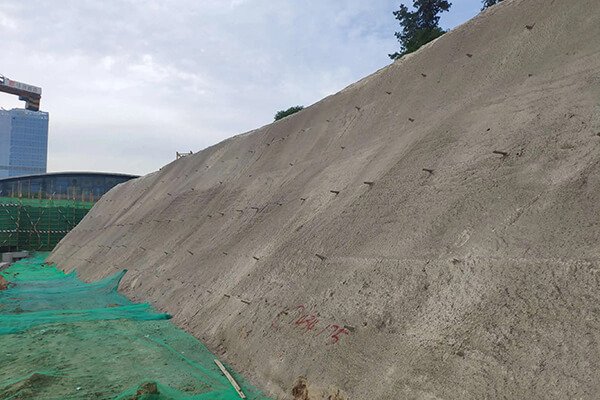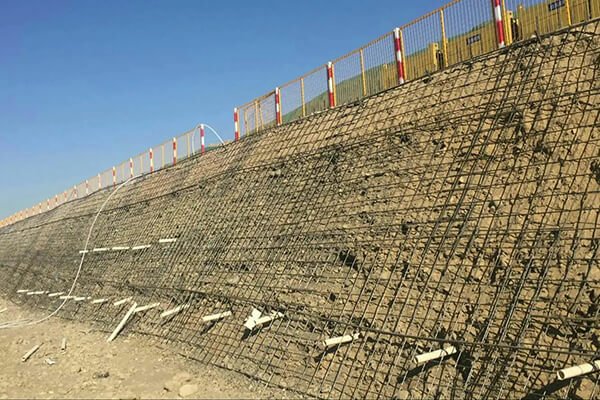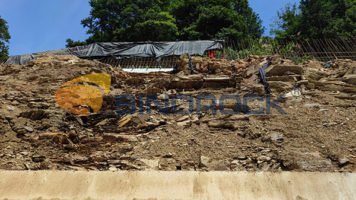Soil nail is a kind of support material to reinforce unstable conditions in geological engineering. Soil nail wall is a new technology developed recently to reinforce the slope of the foundation when excavating.
What Is Soil Nail Support?
Soil nailing refers to the reinforcement and support technology of geotechnical engineering with soil nails as the main force-bearing components. It consists of a dense group of soil nails, reinforced in-situ soil, a sprayed concrete surface, a steel mesh placed on the surface, and the necessary waterproofing system.
Soil nails refer to slender rods used to reinforce and anchor in-situ soil at the same time, usually made by drilling holes in the geotechnical medium, inserting deformed steel bars, and grouting along the full length of the holes. Relying on the interfacial bonding force or friction force between the soil nail and the soil body, the soil nail is passively stressed under the condition of soil deformation and mainly bears the tensile force.

How Do You Install Traditional Soil Nails?
Trim Slope
The soil should be excavated in layers and sections, the excavation depth of each layer is consistent with the vertical spacing of soil nails, and the excavation elevation is 200mm below the soil nail position. After each layer of soil is excavated, it should be trimmed to remove the protruding soil and compact the loose soil on the surface, in order to ensure the smoothness of the sprayed concrete surface.
First Shot Concrete
The spraying sequence of shotcrete should be from top to bottom. The distance between the spray head and the sprayed surface should be controlled in the range of 0.8~1.5m. The spraying direction is vertical to the spraying surface. speed to prevent concrete from slumping.
Locate the Hole and Drill
Before drilling, we need to locate the hole positions. When drilling, it is necessary to drill slowly at the beginning until reaching the stable layers.
Put the Soil Nail
Put the soil nail, usually made of rebar, steel strand, or other materials, in the drilling hole.
Grout
The grouting should be done by pressure grouting. The pipe should be inserted 250~500mm from the bottom of the hole first, then a grouting plug should be set at the orifice. The pressure should be maintained for 1~2min after filling. When grouting, pull out the pipe slowly and evenly, and the grout outlet should always be buried under the surface of the grout in the hole to ensure that all the gas in the hole can be discharged.
Binding Steel Mesh
Reinforcement mesh should be constructed layer by layer with soil nails and set layer by layer, and the thickness of the protective layer should not be less than 20mm.

Second Shot Concrete
Concrete shooting construction starts after the steel mesh and soil nails are accepted and accepted. The sprinkler head is kept perpendicular to the sprayed surface. When the thickness of the surface layer exceeds 100mm, the concrete should be sprayed in layers. The thickness of the first layer should not be less than 40mm. After spraying a layer of concrete, the lap width is not less than 2 times the thickness, and the joints should be staggered.
What Is Self-Drilling Soil Nail?
The self-drilling soil nail is composed of a full-thread hollow anchor bar, a coupler, a nut, a sacrificial drill bit, a plate, and a centralizer. Self-drilling soil nail has a rich variety of drill bits, and the drill bit can be selected according to the properties of rock and soil, which can improve the drilling efficiency.

How to Install Self-Drilling Soil Nail?
Trim Slope – First Shot Concrete – Locate the Hole – Drill and Grout Simultaneously – Binding Steel Mesh – Second Shot Concrete
Compared with traditional soil nails, installing self-drilling soil nails is much easier because the hollow bar of the self-drilling soil nails is a drill rod as well as a rock bolt. It is no need to pull out the drill rod after drilling the hole. self-drilling soil nail combines the drilling, grouting, and anchoring in one process and is suitable for broken rock, loose soil, and geological conditions where is difficult to drill holes.
In addition, the hollow anchor bar can be cut arbitrarily and lengthened by the coupler. Therefore, the self-drilling anchor bolt is suitable for construction in a narrow space that large equipment can’t enter.
Applications
Soil nail support is suitable for the permanent support of underground and slope engineering, and the design and construction of temporary support during vertical excavation of foundation pit or grading excavation. Drilling and grouting soil nails with steel bars as the central nail body should be used, the depth of the foundation pit should not exceed 21m, and the service life of the temporary support should not exceed 24 months. Soil nail support is suitable for general geotechnical media, but also for the following unfavorable geological bodies, such as plastic clay, weakly cemented (including capillary water-bonded) silt, sand, and breccia, soft soil, fill, and weathered rock formations, and so on.


